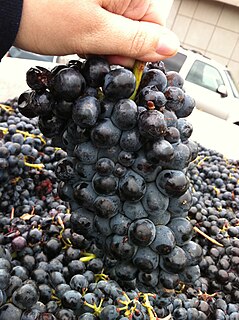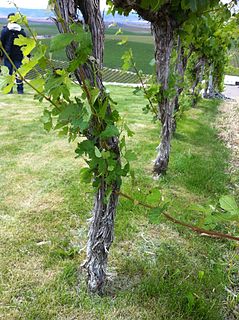
Nebbiolo is an Italian red wine grape variety predominantly associated with its native Piedmont region, where it makes the Denominazione di Origine Controllata e Garantita (DOCG) wines of Barolo, Barbaresco, Roero, Gattinara, Carema and Ghemme. Nebbiolo is thought to derive its name from the Italian nebbia or Piedmontese nebia, meaning "fog". During harvest, which generally takes place late in October, a deep, intense fog sets into the Langhe region where many Nebbiolo vineyards are located. Alternative explanations refers to the fog-like glaucous veil that forms over the berries as they reach maturity, or that perhaps the name is derived instead from the Italian word nobile, meaning noble. Nebbiolo produces lightly-colored red wines which can be highly tannic in youth with scents of tar and roses. As they age, the wines take on a characteristic brick-orange hue at the rim of the glass and mature to reveal other aromas and flavors such as violets, tar, wild herbs, cherries, raspberries, truffles, tobacco, and prunes. Nebbiolo wines can require years of aging to balance the tannins with other characteristics.

Barbera is a red Italian wine grape variety that, as of 2000, was the third most-planted red grape variety in Italy. It produces good yields and is known for deep color, full body, low tannins and high levels of acidity.

Dolcetto is a black Italian wine grape variety widely grown in the Piedmont region of northwest Italy. The Italian word dolcetto means "little sweet one", but it is not certain that the name originally carried any reference to the grape’s sugar levels: it is possible that it derives from the name of the hills where the vine is cultivated. In any case the wines produced are nearly always dry. They can be tannic and fruity with moderate, or decidedly low, levels of acidity and are typically meant to be consumed within a few years after release.
Freisa is a red Italian wine grape variety grown in the Piedmont region of north-west Italy, primarily in Monferrato and in the Langhe, but also further north in the provinces of Turin and Biella. Freisa is a vigorous and productive vine whose round, blue-black grapes are harvested in early October. The three-lobed leaves are relatively small and the bunches are elongated in form. By the 1880s it had become one of the major Piedmontese grapes, and in that period its cultivation was stimulated by the vine’s resistance to the downy mildew caused by the Plasmopara viticola fungus. Wines made from the Freisa grape are red and usually somewhat sweet and lightly sparkling, or foaming. Still and fully sparkling versions are also produced, however, as are dry and more decidedly sweet styles. In the Canavese there is also a rosé which can be made primarily from Freisa according to Denominazione di origine controllata (DOC) regulations.

Piemonte wine is the range of Italian wines made in the region of Piedmont in the northwestern corner of Italy. The best-known wines from the region include Barolo and Barbaresco. They are made from the Nebbiolo grape. These wines are ideal for storage and a well-aged Barolo for instance may leave a feeling of drinking velvet because the tannins are polished and integrated more and more into the wine. As the wine matures the colour becomes more brownish and rust-red.

Lombardia (Lombardy) wine is the Italian wine produced in the Lombardy region of north central Italy. The region is known particularly for its sparkling wines made in the Franciacorta and Oltrepò Pavese areas. Lombardy also produces still red, white and rosé wines made from a variety of local and international grapes including Nebbiolo wines in the Valtellina region, Trebbiano di Lugana white wines produced with the Chiaretto style rosé along the shores of Lake Garda. The wine region currently has 15 Denominazione di origine controllata (DOC), 3 Denominazione di Origine Controllata e Garantita (DOCG) and 13 Indicazione Geografica Tipica (IGT) designations. The main cities of the region are Milan, Bergamo and Brescia. The region annually produces around 1.3 million hectolitres of wine, more than the regions of Friuli-Venezia Giulia, Marche, Trentino-Alto Adige/Südtirol and Umbria.

Arneis is a white Italian wine grape variety originating from Piedmont, Italy. It is most commonly found in the hills of the Roero, northwest of Alba, where it is part of the white Denominazione di Origine Controllata e Garantita (DOCG) wines of Roero. It can also be used to produce DOC wines in Langhe. Arneis is so called because it is regarded as a somewhat difficult variety to grow. It is a crisp and floral varietal, and has been grown for centuries in the region. The white wines made from the Arneis grape tend to be dry and full bodied with notes of pears and apricots.
Uva Rara is a red Italian wine grape variety that is grown in the Piedmont and Lombardy wine regions of northern Italy. The grape is a permitted blending variety along with Nebbiolo in the Denominazione di Origine Controllata e Garantita (DOCG) wines of Ghemme. In the Denominazione di Origine Controllata (DOC) wine region of Oltrepò Pavese the grape is often blended with Barbera and Croatina. While Uva Rara's name means "rare grape" in Italian, the variety is actually widely planted with 608 hectares of the vine recorded in Italy in 2000.
Vespolina is a red Italian wine grape variety that is planted in Piedmont around Gattinara and Ghemme. Ampelographer believe that the grape is most likely indigenous to this area of Piedmont and recent DNA profiling identified a parent-offspring relationship with Nebbiolo. Outside Piedmont it is found in the Lombardy region of Oltrepò Pavese where the grape is known as Ughetta. In Gattinara, Vespolina is sometimes blended with Nebbiolo and Bonarda Piemontese. Unlike the white Italian grape Vespaiolo, the root of the name Vespolina does not have a direct connection with vespe or wasp. However the true origins of the name are still unclear.
Biancame is a white Italian wine grape variety that is grown in the Marche and Emilia-Romagna regions of Italy. Here it is an important component in the Denominazione di origine controllata (DOC) wines of Bianchello del Metauro and Colli di Rimini.
Fortana is a red Italian wine grape variety grown primarily in the Emilia–Romagna region of northern Italy. A permitted grape variety in several Denominazione di origine controllatas (DOCs), mostly in Emilia, Fortana mostly contributes tartness and acidity in red blends.
Rossola nera is a red Italian wine grape variety that has been growing in the Valtellina region of Lombardy since at least the 17th century. In 2004 DNA profiling determined that the grape has a parent-offspring relationship with the Piedmont wine grape Nebbiolo though which variety is the parent and which is the offspring is not yet clear. However, most ampelographers believe that Nebbiolo is likely the parent variety since written records in Piedmont have noted Nebbiolo being grown since at least the 13th century.
Rossignola is a red Italian wine grape variety that is grown in the Veneto wine region of northeast Italy. The variety was first mentioned growing in the province of Verona in the early 19th century and today is a permitted blending variety in several Denominazione di origine controllata (DOC) wines of the Veneto including Bardolino and Valpolicella.
Colombana nera is a red Italian wine grape variety that is grown in Emilia-Romagna and Tuscany. Despite similarities in name, the grape did not get its name from nor is it grown in the San Colombano al Lambro region of Lombardy nor is it permitted in the Denominazione di origine controllata (DOC) wine of the same name. Rather, ampelographers believe that Colombana nera is named after the Abbey of San Colombano located in the commune of Bobbio in the Piacenza province of Emilia-Romagna where the grape has had a long history of cultivation.
Besgano bianco is a white Italian wine grape variety that was historically used in the production of the dessert wine Vin Santo, blended with Malvasia Bianca Lunga and Verdea, but today is rarely planted and is more often used for table grape production than winemaking. The grape is also known as Colombana bianca but it is not a color mutation of the Tuscan and Emilia-Romagna wine grape Colombana nera.
Grisa nera is a red Italian wine grape variety that is grown in the Piedmont wine region of northwest Italy where it is used in both winemaking and as a table grape. The grape is most often used as a minor blending component with wines made from Barbera, Neretta Cuneese and Plassa.

Rossolino nero is a red Italian wine grape variety that is grown in the Valtellina region of Lombardy in northern Italy. The grape was once thought to be a clone of Rossola nera but DNA profiling in the late 20th and early 21st century has shown that the two grapes are distinct varieties but are likely related. Around the village of Teglio, a pink-skinned color mutation of Rossolino nero exist that is known as Rossolino Rosa.
Alionza is a white Italian wine grape variety that is grown in the Emilia-Romagna region of north central Italy, where it has a long history of being used since the 14th century as both a table grape and blending grape for wine production. While sometimes confused with the Greek wine grape Sklava, DNA analysis in the early 21st century has suggested, instead, that Alionza may be closely related to the Tuscan wine grape Trebbiano.
Avarengo is a red Italian wine grape variety that is grown in the Piedmont wine region of northwest Italy where it is a permitted blending component in the Denominazione di origine controllata (DOC) wines of Pinerolese. Here the grape is usually blended with Avanà, Neretta Cuneese and other local red Piemontese varieties.
Bubbierasco is a red Italian wine grape variety that is grown in the province of Cuneo in the Piedmont wine region of northwest Italy. The grape is a natural crossing of the Nebbiolo grape, famous for the red wines of Barolo and Barbaresco, and Bianchetta di Saluzzo, a white grape variety that has been historically grown around the town of Saluzzo.








